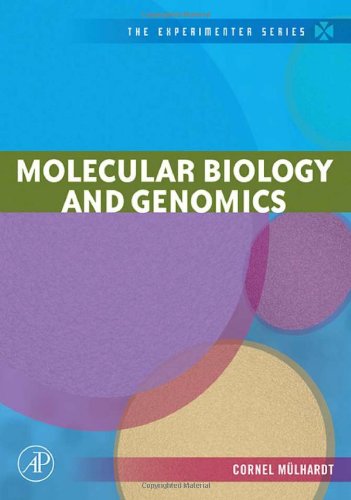(Ebook PDF) Molecular Biology and Genomics The Experimenter Series 1st Edition by Cornel Mulhardt ISBN 9780080467665 0080467660 full chapters
$50.00 Original price was: $50.00.$35.00Current price is: $35.00.
(Ebook PDF) Molecular Biology and Genomics The Experimenter Series 1st Edition by Cornel Mulhardt -Ebook PDF Instant Download/Delivery:9780080467665, 0080467660
Instant download Full Chapter of Molecular Biology and Genomics The Experimenter Series 1st Edition after payment

Product details:
ISBN 10:0080467660
ISBN 13:9780080467665
Author: Cornel Mulhardt
Never before has it been so critical for lab workers to possess the proper tools and methodologies necessary to determine the structure, function, and expression of the corresponding proteins encoded in the genome. Mulhardt’s Molecular Biology and Genomics helps aid in this daunting task by providing the reader with tips and tricks for more successful lab experiments. This strategic lab guide explores the current methodological variety of molecular biology and genomics in a simple manner, addressing the assets and drawbacks as well as critical points. It also provides short and precise summaries of routine procedures as well as listings of the advantages and disadvantages of alternative methods.
* Shows how to avoid experimental dead ends and develops an instinct for the right experiment at the right time
* Includes a handy Career Guide for researchers in the field
* Contains more than 100 extensive figures and tables
Table of Contents:
- Chapter 1 What Is Molecular Biology?
- 1.1 The Substrate of Molecular Biology: The Molecular World for Beginners
- 1.2 What Is Required for This Work?
- 1.3 Safety in the Laboratory
- Chapter 2 Fundamental Methods
- 2.1 Differences in Nucleic Acids
- 2.2 Precipitation and Concentration of Nucleic Acids
- 2.2.1 Alcohol Precipitation
- 2.2.2 Concentrators
- 2.2.3 Savant Speed Vac
- 2.2.4 Salting Out
- 2.3 Purification of Nucleic Acids
- 2.3.1 Phenol-Chloroform Extraction
- 2.3.2 Precipitation Using Polyethylene Glycol
- 2.3.3 Protein-Binding Filter Membranes
- 2.3.4 Anion-Exchange Columns
- 2.3.5 Glass Milk
- 2.3.6 Cesium Chloride Density Gradient
- 2.3.7 Dialysis
- 2.4 Determining the Concentration of Nucleic Acid Solutions
- 2.4.1 Optical Density Measurements with the Aid of Absorption Spectrometry
- 2.4.2 Determination of Concentration by Means of Agarose Gels
- 2.4.3 Dot Quantification
- 2.4.4 Fluorometric Determination
- 2.4.5 Nucleic Acid Dipsticks
- 2.4.6 Enzymatic Evidence
- 2.5 Methods of DNA Preparation
- 2.5.1 Preparation of Plasmid DNA on a Small Scale
- 2.5.2 Preparation of Plasmid DNA on a Large Scale
- 2.5.3 Bacterial Media
- 2.5.4 Preparation of Phage DNA
- 2.5.5 Preparation of Single-Stranded DNA with the Aid of Helper Phages
- 2.5.6 Preparation of Genomic DNA
- Chapter 3 The Tools
- 3.1 Restriction Enzymes
- 3.1.1 Nomenclature
- 3.1.2 The Activity Test
- 3.1.3 Making a Restriction Digestion
- 3.1.4 Difficulties Associated with Restriction Digestion
- 3.1.5 Works of Reference for Restriction Digestion
- 3.2 Gels
- 3.2.1 Agarose Gels
- 3.2.2 Isolating DNA Fragments from Agarose Gels
- 3.2.3 Polyacrylamide Gels
- 3.2.4 Isolating DNA Fragments from Polyacrylamide Gels
- 3.2.5 Pulse-Field Gel Electrophoresis
- 3.2.6 Capillary Electrophoresis
- 3.3 Blotting
- 3.3.1 Southern Blots
- 3.3.2 Northern Blots
- 3.3.3 Dot Blots and Slot Blots
- Chapter 4 The Polymerase Chain Reaction
- 4.1 Standard Polymerase Chain Reaction
- 4.2 Suggestions for Improving the Polymerase Chain Reaction
- 4.2.1 Nested Polymerase Chain Reaction
- 4.2.2 Multiplex Polymerase Chain Reaction
- 4.2.3 Amplification of Longer DNA Fragments
- 4.3 PCR Applications
- 4.3.1 Reverse Transcription-Polymerase Chain Reaction
- 4.3.2 Rapid Amplification of cDNA Ends
- 4.3.3 Amplification of Coincidental Products
- 4.3.4 Classic Quantitative Polymerase Chain Reaction
- 4.3.5 Real-Time Quantitative Polymerase Chain Reaction
- 4.3.6 Inverse Polymerase Chain Reaction
- 4.3.7 Biotin-RAGE Method and Supported Polymerase Chain Reaction
- 4.3.8 Mutagenesis with Modified Primers
- 4.3.9 Amplification Refractory Mutation System
- 4.3.10 In Situ Polymerase Chain Reaction
- 4.3.11 Cycle Sequencing
- 4.3.12 cDNA Synthesis
- 4.3.13 Single-Cell Polymerase Chain Reaction
- Chapter 5 RNA
- 5.1 Inactivating RNases
- 5.2 Methods of RNA Isolation
- 5.2.1 Single-Step Method
- 5.2.2 Lysis with Nonidet P40
- 5.2.3 General Information
- 5.2.4 Determination of the RNA Concentration
- 5.3 Methods of mRNA Isolation
- 5.3.1 Purchasing RNA
- 5.4 Reverse Transcription: cDNA Synthesis
- 5.5 In Vitro Transcription: RNA Synthesis
- 5.6 RNA Interference
- Chapter 6 Cloning DNA Fragments
- 6.1 The Basics of Cloning
- 6.1.1 The Vector
- 6.1.2 The DNA Fragment
- 6.1.3 Fill-in Reaction
- 6.1.4 DNA Quantities
- 6.1.5 The Ligation
- 6.1.6 Cloning Polymerase Chain Reaction Products
- 6.1.7 Cloning with Recombinase Systems
- 6.2 Choosing Vectors for Cloning
- 6.2.1 Plasmids
- 6.2.2 Phages
- 6.2.3 Cosmids
- 6.2.4 P1 Artificial Chromosomes and Bacterial Artificial Chromosomes
- 6.2.5 Yeast Artificial Chromosomes
- 6.3 Choosing the Bacteria
- 6.4 Construction of Competent Cells and Their Transformation
- 6.4.1 Calcium Chloride Method
- 6.4.2 Rubidium Chloride Method
- 6.4.3 TSS Method
- 6.4.4 Electroporation
- 6.4.5 Testing the Competency of Bacteria
- 6.5 Problems Associated with Cloning
- 6.6 Storage of Clones
- Chapter 7 Hybridization: How to Track Down DNA
- 7.1 Production of Probes
- 7.1.1 Methods for the Production of Labeled Probes
- 7.2 Hybridization
- 7.2.1 The Hybridization Buffer
- 7.2.2 The Hybridization Vessels
- 7.2.3 The Hybridization Temperature
- 7.2.4 Washing
- 7.3 Verification of Labeled DNA
- 7.3.1 Autoradiography
- 7.3.2 Nonradioactive Methods of Detection
- 7.4 Screening of Recombinant DNA Banks
- 7.4.1 Plating Out the Bank
- 7.4.2 Filter Transfer
- 7.4.3 Filter Hybridization
- 7.4.4 Filter Exposure
- 7.4.5 Clone Detection
- 7.4.6 Bank Screening in the Future
- 7.5 Two-Hybrid System
- Chapter 8 DNA Analysis
- 8.1 Sequencing
- 8.1.1 Radioactive Sequencing
- 8.1.2 Nonradioactive Sequencing and Automatic Sequencing Units
- 8.1.3 Minisequencing
- 8.1.4 Pyrosequencing
- 8.1.5 Idiosyncrasies in Sequencing: Octamers
- 8.2 Methods of Analyzing DNA for Mutations
- 8.2.1 Restriction Fragment Length Polymorphism
- 8.2.2 Single-Strand Conformation Polymorphism
- 8.2.3 Denaturing Gradient Gel Electrophoresis
- 8.2.4 Temporal Temperature Gradient Electrophoresis
- 8.2.5 Heteroduplex Analysis
- 8.2.6 Amplification Refractory Mutation System
- 8.2.7 Enzyme Mismatch Cleavage
- 8.2.8 Protein Truncation Test
- Chapter 9 Investigating the Function of DNA Sequences
- 9.1 Investigating Transcription in Tissues
- 9.1.1 Ribonuclease Protection Assay
- 9.1.2 Real-Time Quantitative Polymerase Chain Reaction
- 9.1.3 In Situ Hybridization
- 9.1.4 Fluorescence In Situ Hybridization of Chromosomes
- 9.1.5 In Situ Polymerase Chain Reaction
- 9.1.6 Microarrays
- 9.2 Mutagenesis
- 9.3 In Vitro Translation
- 9.4 Expression Systems
- 9.4.1 Bacterial Expression Systems
- 9.4.2 Baculoviral Expression Systems
- 9.4.3 Additional Expression Systems
- 9.4.4 Heterologous Expression in Mammalian Cells
- 9.4.5 Transfection Methods
- 9.4.6 Cotransfection of Several Genes
- 9.4.7 Transient and Stabile Transfections
- 9.4.8 Reporter Genes
- 9.5 Transgenic Mice
- 9.5.1 Methods of Gene Transfer
- 9.6 Regulation of Transgenic Expression
- 9.6.1 The Tet System
- 9.6.2 The Ecdysone System
- 9.7 Gene Therapy
- 9.8 Genomics
- Chapter 10 Using Computers
- 10.1 Something Quite Earnest
- 10.2 A Matter of Practice
- Chapter 11 Suggestions for Career Planning: The Machiavelli Short Course for Young Researchers
- Chapter 12 Concluding Thoughts
People also search:
differentiate microbial genetics molecular biology and genomics
academia molecular biology and genomics predatory
institute of molecular biology and genomics dehradun
fellowship in molecular biology and genomics
institute of molecular biology and genomics
Tags:
Cornel Mulhardt,Molecular Biology,Genomics


